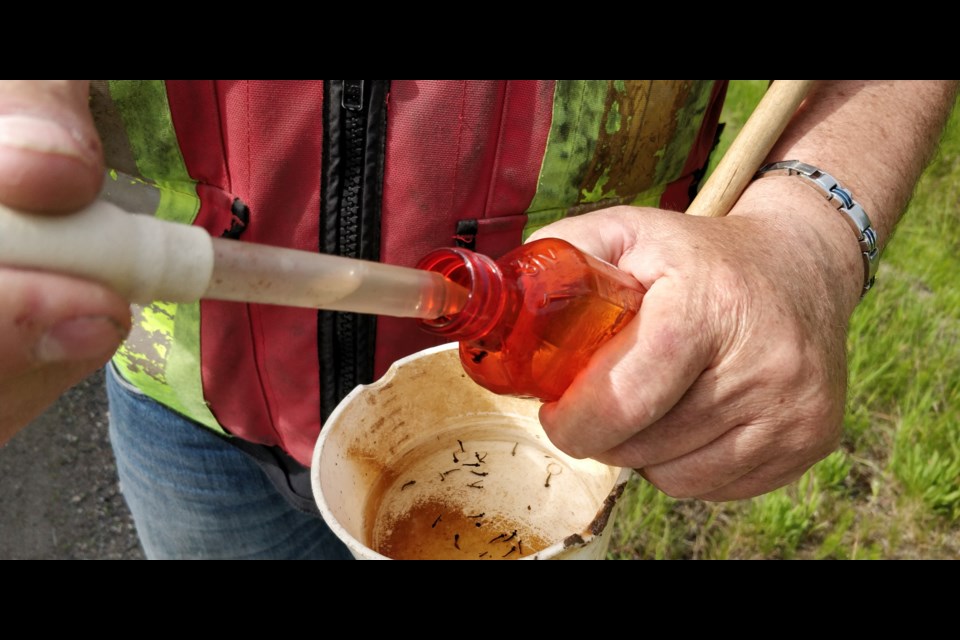They’re back.
In case you haven’t noticed, the mosquito buffet is on and those miserable uninvited pests are feasting on humans and other animals who venture into the great outdoors.
The good news is the city’s swat team is on the case, trying to prevent those pesky critters from developing from the larva stage into full-grown adult bloodsuckers. Two crews from Duka Environmental Services are on the hunt searching for mosquitos armed with what it takes to wipe them out.
Starting in late April and continuing until the end of June, the teams of environmental technicians have been treating the water pools with a natural bacteria larvacide to try to control the buzzing swarms that make life miserable. When the larvae count in a sample scoop is sufficient, bits of larvacide which look like kernels of corn are dumped, which float on the surface of the water.
“Mosquito larvae hatches and goes through four stages before it pupates and becomes an adult and while they’re in that larvae stage we find them,” said Claire Watkins, a city environmental technician.
“The mosquito larvae eats the bacteria and it crystalizes in their guts and they die. It’s very specific and only works on mosquito and black fly larvae and certain midges.”
Watkins said reducing black-fly counts at the same time would be a desirable double-whammy to take the bite out of summer but unfortunately mosquitos and flies don’t ingest the bacillus thuringiensis israelensis (BTI) bacteria in the pellets the same way.
“Mosquitoes needs stagnant still water because the larvae attach to the surface of the water to breathe, whereas black fly larvae have to have running water,” said Watkins.
“We have to look for the presence of larvae before we treat. We treat within the city and our program is targeted to that first big hatch of mosquitoes that usually come from snow-melt sites.”
The cool rainy weather the city has had the past couple weeks is ideal for breeding mosquitoes.
“When it’s hot and dry, they don’t have the mechanisms to survive,” said Watkins. “How long they live depends on the weather and whether they’ve got harbourage areas. In damp, forested shady areas you can find a lot of mosquitoes because it’s cool enough to survive.
“If we get a long dry hot spell the mosquitoes get very hungry because they know they need to get that blood meal and lay their eggs before they die. They get more desperate.”
There are 29 known species of mosquito known to inhabit the city and Watkins said each has its taste preferences. None of them spread diseases and they are usually most troublesome in the spring.
“Some mosquitoes like humans, some like birds and some like frogs,” she said. “But the ones that come out in the snow melt, the aedes species of mosquito are quite often the ones that go after humans. They’re very small and very aggressive. The most prolific one right now out of the first hatch is aedes vexans. The big slow-moving mosquitoes are the overwintering males and they don’t bite.”
Cottonwood Island Park where the Nechako River meets the Fraser is prone to flooding this time of year and is one of the known hotspots for mosquitoes. Unfortunately, because a lot of those back channels are connected to the river, the city is bound by federal regulations which to not allow larvacide treatment in areas connected to fish-bearing water.
“When the water disconnects and there’s still larvae present then we can treat,” said Watkins. “But if the rivers are rising and lowering and we get some back channels for a few days and we know the river is going to rise again we can’t treat. A lot of time the larvae hatch and there’s nothing we can do about it. Anywhere there’s fish present, we can’t treat.”
If the mosquito clouds get too thick, Watkins has the answer for that.
“A good mosquito repellant is sometimes worth its weight in gold,” she said.
Watkins offers a few tips for residents hoping to rid their own yards of swarming mosquitoes. Ditches of remaining snow-melt that dry into small puddles tend to concentrate mosquito larvae and getting rid of standing water is key in the bug battle. One of the puddles she sampled last week contained 125 mosquito larvae in a 300-millilitre scoop.
“Old tires are the worst, because they’re black and it’s hot and they’re protected,” she said. “Even changing your dog’s water or birdbaths helps. Clean out your gutters. Keep the grass in your yard trimmed.”
Pond owners can wipe out mosquito larvae by installing a fountain that moves the water.
Mosquito dunks of bacterial larvacide are readily available for property owners who have lagoons and they last for about 30 days.
“I don’t recommend mosquito zappers because they get all the good bugs too, like parasitic wasps (which kill caterpillars, flies and beetles) and all these good bugs that keep everything in check,” said Watkins. “Any flying insects are attracted to mosquito zappers.”
The city will call in exterminators to get rid of ground-based wasps, especially those near playgrounds or popular outdoor areas which are more territorial and more aggressive than paper wasps.
.



